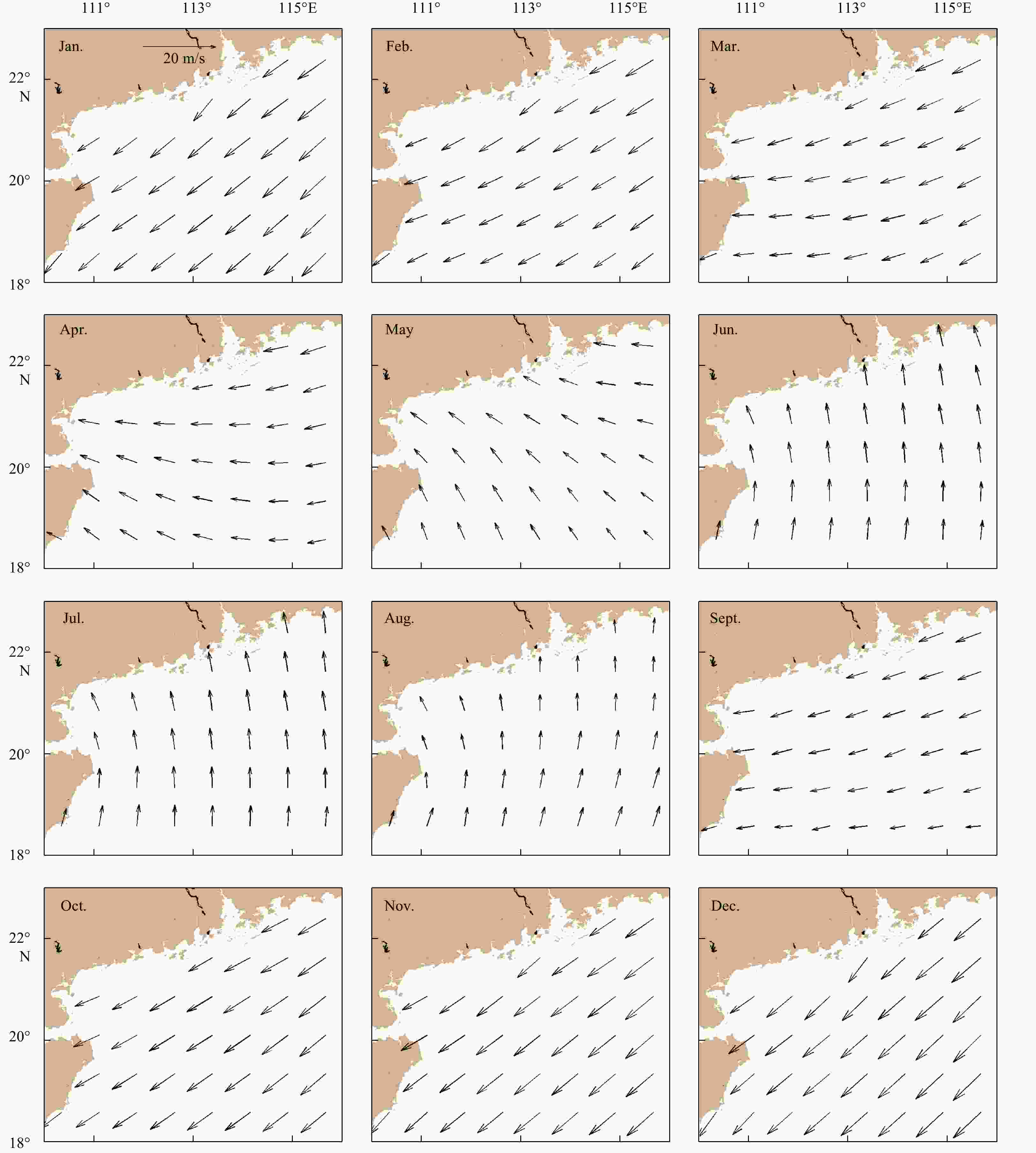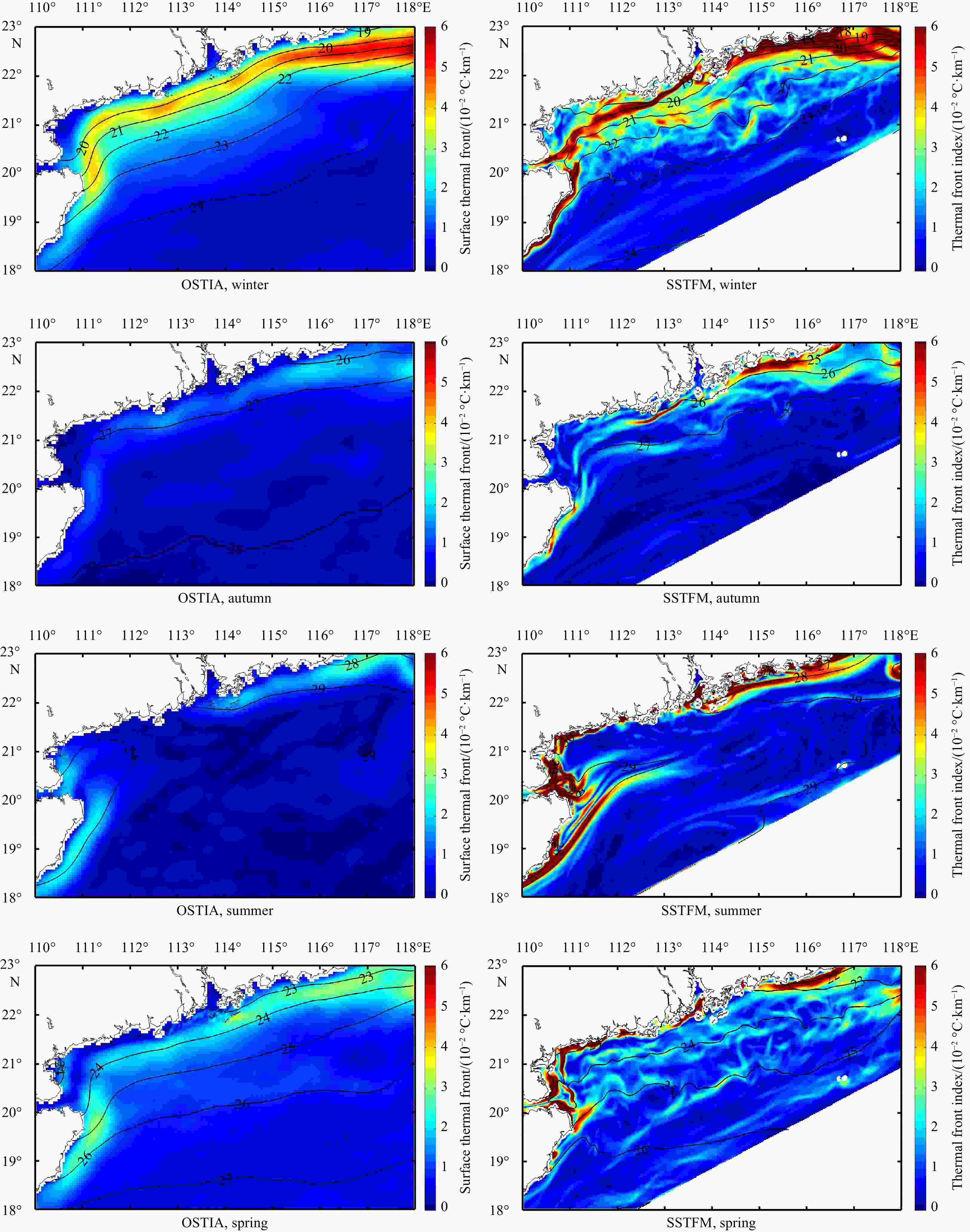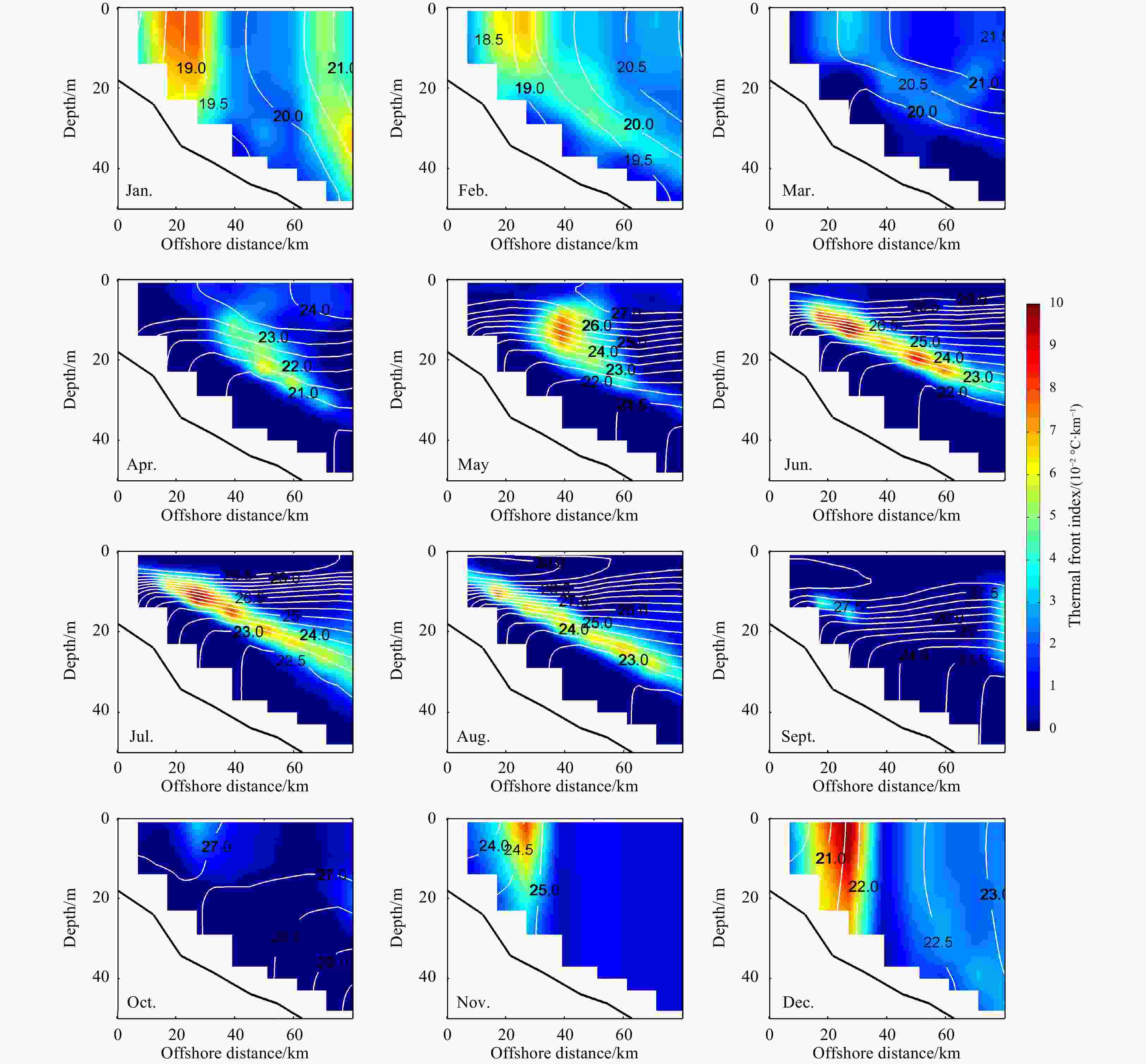Seasonal variation in the three-dimensional structures of coastal thermal front off western Guangdong
-
Abstract: The seasonal structure and dynamic mechanism of oceanic surface thermal fronts (STFs) along the western Guangdong coast over the northern South China Sea shelf were analyzed using in situ observational data, remote sensing data, and numerical simulations. Both in situ and satellite observations show that the coastal thermal front exhibits substantial seasonal variability, being strongest in winter when it has the greatest extent and strongest sea surface temperature gradient. The winter coastal thermal front begins to appear in November and disappears after the following April. Although runoff water is more plentiful in summer, the front is weak in the western part of Guangdong. The frontal intensity has a significant positive correlation with the coastal wind speed, while the change of temperature gradient after September lags somewhat relative to the alongshore wind. The numerical simulation results accurately reflect the seasonal variation and annual cycle characteristics of the frontal structure in the simulated area. Based on vertical cross-section data, the different frontal lifecycles of the two sides of the Zhujiang (Pearl) River Estuary are analyzed.
-
Key words:
- oceanic thermal fronts /
- South China Sea /
- seasonal dynamics
-
Figure 1. Bathymetry (contours in m), in situ CTD stations (red dots). Four repeated cruise observations with 18 hydrographic transects along the cross-shelf red lines were implemented in summer (2006), winter (2006/2007), spring (2007), and autumn (2007), respectively. The blue box is the model area.
Figure 6. Seasonal cycles of alongshore (a) and offshore (b) wind speed (blue) and thermal front index (red) averaged over the shelf (yellow dashed box shown in Fig. 4). The thermal front index is defined as the intensity of the surface thermal front multiplied by the probability of front occurrence. The time series are all normalized by their respective root-mean-square variance.
Table 1. Total number of CTDs and CTDs selected in this study from the 4 surveys
Cruise Survey period Total number of CTDs Number of selected CTDs Winter 2006/2007 Dec. 20, 2006–Jan. 20, 2007 234 234 Spring 2007 Apr. 6–May 4, 2007 233 233 Summer 2006 Jul. 14–Aug. 28, 2006 220 186 Autumn 2007 Oct. 9–Dec. 5, 2007 234 234 -
[1] Atlas R, Hoffman R N, Bloom S C, et al. 1996. A multiyear global surface wind velocity dataset using SSM/I wind observations. Bulletin of the American Meteorological Society, 77(5): 869–882. doi: 10.1175/1520-0477(1996)077<0869:AMGSWV>2.0.CO;2 [2] Belkin I M, Cornillon P C, Sherman K. 2009. Fronts in large marine ecosystems. Progress in Oceanography, 81(1–4): 223–236 [3] Bleck R. 2002. An oceanic general circulation model framed in hybrid isopycnic-Cartesian coordinates. Ocean Modelling, 4(1): 55–88. doi: 10.1016/S1463-5003(01)00012-9 [4] Bost C A, Cotté C, Bailleul F, et al. 2009. The importance of oceanographic fronts to marine birds and mammals of the southern oceans. Journal of Marine Systems, 78(3): 363–376. doi: 10.1016/j.jmarsys.2008.11.022 [5] Cabrera O C, Villanoy C L, David L T, et al. 2011. Barrier layer control of entrainment and upwelling in the Bohol Sea, Philippines. Oceanography, 24(1): 130–141. doi: 10.5670/oceanog.2011.10 [6] Chang Y, Shimada T, Lee M A, et al. 2006. Wintertime sea surface temperature fronts in the Taiwan Strait. Geophysical Research Letters, 33(23): L23603. doi: 10.1029/2006GL027415 [7] Chelton D B, Wentz F J. 2005. Global microwave satellite observations of sea surface temperature for numerical weather prediction and climate research. Bulletin of the American Meteorological Society, 86(8): 1097–1116. doi: 10.1175/BAMS-86-8-1097 [8] Chow C H, Hu J H, Centurioni L R, et al. 2008. Mesoscale Dongsha cyclonic eddy in the northern South China Sea by drifter and satellite observations. Journal of Geophysical Research: Oceans, 113(C4): C04018. doi: 10.1029/2007JC004542 [9] D’Asaro E, Lee C, Rainville L, et al. 2011. Enhanced turbulence and energy dissipation at ocean fronts. Science, 332(6027): 318–322. doi: 10.1126/science.1201515 [10] D’Croz L, Maté J L. 2004. Experimental responses to elevated water temperature in genotypes of the reef coral Pocillopora damicornis from upwelling and non-upwelling environments in Panama. Coral Reefs, 23(4): 473–483. doi: 10.1007/s00338-004-0397-7 [11] Egbert G D, Bennett A F, Foreman M G G. 1994. TOPEX/Poseidon tides estimated using a global inverse model. Journal of Geophysical Research: Oceans, 99(C12): 24821–24852. doi: 10.1029/94JC01894 [12] Egbert G D, Erofeeva S Y. 2002. Efficient inverse modeling of barotropic ocean tides. Journal of Atmospheric and Oceanic Technology, 19(2): 183–204. doi: 10.1175/1520-0426(2002)019<0183:EIMOBO>2.0.CO;2 [13] Farr T G, Kobrick M. 2000. Shuttle radar topography mission produces a wealth of data. EOS, 81(48): 583–585. doi: 10.1029/EO081i048p00583 [14] Gan Jianping, Cheung A, Guo Xiaogang, et al. 2009. Intensified upwelling over a widened shelf in the northeastern South China Sea. Journal of Geophysical Research: Oceans, 114(C9): C09019. doi: 10.1029/2007JC004660 [15] Gan Jianping, Ho H S, Liang Linlin. 2013. Dynamics of intensified downwelling circulation over a widened shelf in the northeastern South China Sea. Journal of Physical Oceanography, 43(1): 80–94. doi: 10.1175/JPO-D-12-02.1 [16] Holt J, Umlauf L. 2008. Modelling the tidal mixing fronts and seasonal stratification of the Northwest European Continental shelf. Continental Shelf Research, 28(7): 887–903. doi: 10.1016/j.csr.2008.01.012 [17] Hu Jianyu, Kawamura H, Hong Huasheng, et al. 2000. A review on the currents in the South China Sea: Seasonal circulation, South China Sea warm current and Kuroshio intrusion. Journal of Oceanography, 56(6): 607–624. doi: 10.1023/A:1011117531252 [18] Hu Jianyu, Kawamura H, Tang D L. 2003. Tidal front around the Hainan Island, northwest of the South China Sea. Journal of Geophysical Research: Oceans, 108(C11): 3342. doi: 10.1029/2003JC001883 [19] Hwang C, Chen S A. 2000. Circulations and eddies over the South China Sea derived from TOPEX/Poseidon altimetry. Journal of Geophysical Research: Oceans, 105(C10): 23943–23965. doi: 10.1029/2000JC900092 [20] Jing Zhiyou, Qi Yiquan, Fox-Kemper B, et al. 2016. Seasonal thermal fronts on the northern South China Sea shelf: Satellite measurements and three repeated field surveys. Journal of Geophysical Research: Oceans, 121(3): 1914–1930. doi: 10.1002/2015JC011222 [21] Johannessen J A, Kudryavtsev V, Akimov D, et al. 2005. On radar imaging of current features: 2. Mesoscale eddy and current front detection. Journal of Geophysical Research: Oceans, 110(C7): C07017. doi: 10.1029/2004JC002802 [22] Johnston T M S, Rudnick D L, Pallàs-Sanz E. 2011. Elevated mixing at a front. Journal of Geophysical Research: Oceans, 116(C11): C11033. doi: 10.1029/2011JC007192 [23] Letelier J, Pizarro O, Nuňez S. 2009. Seasonal variability of coastal upwelling and the upwelling front off central Chile. Journal of Geophysical Research: Oceans, 114(C12): C12009. doi: 10.1029/2008JC005171 [24] Liu W T. 2002. Progress in scatterometer application. Journal of Oceanography, 58(1): 121–136. doi: 10.1023/A:1015832919110 [25] Liu Sumei, Guo Xinyu, Chen Qi, et al. 2010. Nutrient dynamics in the winter thermohaline frontal zone of the northern shelf region of the South China Sea. Journal of Geophysical Research: Atmospheres, 115(C11): C11020. doi: 10.1029/2009JC005951 [26] Liu Qinyu, Jiang Xia, Xie S P, et al. 2004. A gap in the Indo-Pacific warm pool over the South China Sea in boreal winter: Seasonal development and interannual variability. Journal of Geophysical Research: Oceans, 109(C7): C07012. doi: 10.1029/2003JC002179 [27] Liu Zhengyu, Yang Haijun, Liu Qinyu, et al. 2001. Regional dynamics of seasonal variability in the South China Sea. Journal of Physical Oceanography, 31: 272–284. doi: 10.1175/1520-0485(2001)031<0272:RDOSVI>2.0.CO;2 [28] Long M C, Thomas L N, Dunbar R B. 2012. Control of phytoplankton bloom inception in the Ross Sea, Antarctica, by Ekman restratification. Global Biogeochemical Cycles, 26(1): GB1006. doi: 10.1029/2010GB003982 [29] Mahadevan A, D’Asaro E, Lee C, et al. 2012. Eddy-driven stratification initiates North Atlantic spring phytoplankton blooms. Science, 337(6090): 54–58. doi: 10.1126/science.1218740 [30] Nan Feng, He Zhigang, Zhou Hui, et al. 2011. Three long-lived anticyclonic eddies in the northern South China Sea. Journal of Geophysical Research: Oceans, 116(C5): C05002. doi: 10.1029/2010JC006790 [31] Omand M M, D’Asaro E A, Lee C M, et al. 2015. Eddy-driven subduction exports particulate organic carbon from the spring bloom. Science, 348(6231): 222–225. doi: 10.1126/science.1260062 [32] Pauly D, Christensen V. 1995. Primary production required to sustain global fisheries. Nature, 374(6519): 255–257. doi: 10.1038/374255a0 [33] Qiu Chunhua, Mao Huabin, Liu Hailong, et al. 2019. Deformation of a warm eddy in the northern South China Sea. Journal of Geophysical Research: Oceans, 124(8): 5551–5564. doi: 10.1029/2019JC015288 [34] Shi Rui, Guo Xinyu, Wang Dongxiao, et al. 2015. Seasonal variability in coastal fronts and its influence on sea surface wind in the Northern South China Sea. Deep Sea Research Part II: Topical Studies in Oceanography, 119: 30–39. doi: 10.1016/j.dsr2.2013.12.018 [35] Simpson J H, Allen C M, Morris N C G. 1978. Fronts on the continental shelf. Journal of Geophysical Research: Oceans, 83(C9): 4607–4614. doi: 10.1029/JC083iC09p04607 [36] South China Sea Branch of State Ocean Administration of China (SCSB/SOA). 1990. Report on Decadal Hydrographic Investigation in the sea areas adjacent to the shelf of the northern South China Sea (in Chinese). Beijing: China Ocean Press, 42–93 [37] Su Jilan. 2004. Overview of the South China Sea circulation and its influence on the coastal physical oceanography outside the Pearl River Estuary. Continental Shelf Research, 24(16): 1745–1760. doi: 10.1016/j.csr.2004.06.005 [38] Su Danyi, Lin Pengfei, Mao Huabin, et al. 2020. Features of slope intrusion mesoscale eddies in the northern South China Sea. Journal of Geophysical Research: Oceans, 125(2): e2019JC015349. doi: 10.1029/2019JC015349 [39] Su Jian, Pohlmann T. 2009. Wind and topography influence on an upwelling system at the eastern Hainan coast. Journal of Geophysical Research: Oceans, 114(C6): C06017. doi: 10.1029/2008JC005018 [40] Wang Guihua, Li Jiaxun, Wang Chunzai, et al. 2012. Interactions among the winter monsoon, ocean eddy and ocean thermal front in the South China Sea. Journal of Geophysical Research: Oceans, 117(C8): C08002. doi: 10.1029/2012JC008007 [41] Wang Dongxiao, Liu Yun, Qi Yiquan, et al. 2001. Seasonal variability of thermal fronts in the northern South China Sea from satellite data. Geophysical Research Letters, 28(20): 3963–3966. doi: 10.1029/2001GL013306 [42] Wang Dongxiao, Shu Yeqiang, Xue Huijie, et al. 2014. Relative contributions of local wind and topography to the coastal upwelling intensity in the northern South China Sea. Journal of Geophysical Research Oceans: Oceans, 119(4): 2550–2567. doi: 10.1002/2013JC009172 [43] Wang Guihua, Su Jilan, Chu P C. 2003. Mesoscale eddies in the South China Sea observed with altimeter data. Geophysical Research Letters, 30(21): 2121. doi: 10.1029/2003GL018532 [44] Wang Lei, Wong Liya, Wei Hao. 2004. An analysis of the sea-surface thermal fronts in the northern shelf region of the South China Sea with satellite data. Periodical of Ocean University of China (in Chinese), 34(3): 351–357 [45] Xie S-P, Xie Qiang, Wang Dongxiao, et al. 2003. Summer upwelling in the South China Sea and its role in regional climate variations. Journal of Geophysical Research: Oceans, 108(C8): 3261. doi: 10.1029/2003JC001867 [46] Xie Jiping, Zhu Jiang, Li Yan. 2008. Assessment and inter-comparison of five high-resolution sea surface temperature products in the shelf and coastal seas around China. Continental Shelf Research, 28(10–11): 1286–1293 [47] Yanagi T, Koike T. 1987. Seasonal variation in thermohaline and tidal fronts, Seto Inland Sea, Japan. Continental Shelf Research, 7(2): 149–160. doi: 10.1016/0278-4343(87)90076-8 [48] Zhang Yan, Wang Dongxiao, Xia Huayong, et al. 2012. The seasonal variability of an air-sea heat flux in the northern South China Sea. Acta Oceanologica Sinica, 31(5): 79–86. doi: 10.1007/s13131-012-0238-4 [49] Zhang Yan, Xia Huayong, Qian Libing, et al. 2011. Analysis on hydrological characteristics off the Pearl River Estuary in summer and winter of 2006. Journal of Tropical Oceanography (in Chinese), 30(1): 20–28 -





 下载:
下载:











